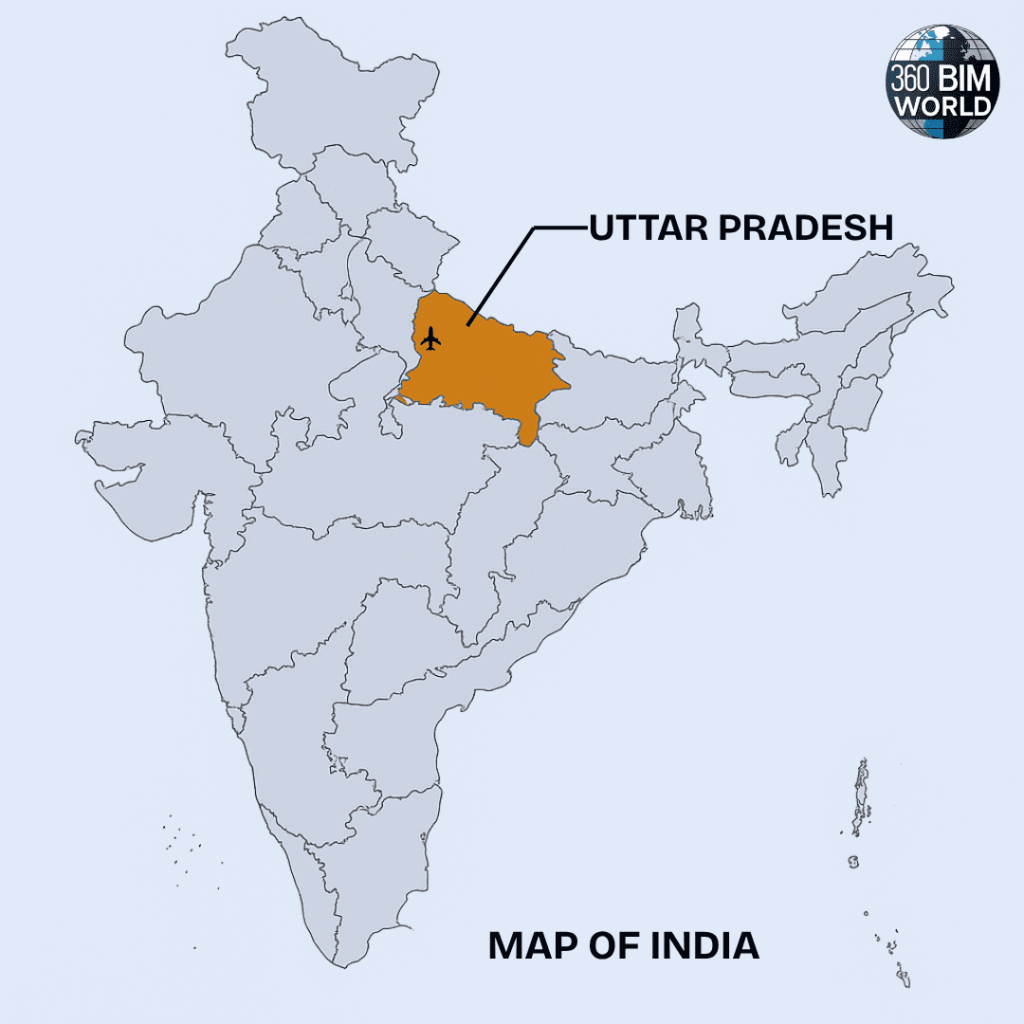Jewar International Airport: India’s Model for Smart, BIM-Driven Infrastructure
Uttar Pradesh, a region steeped in culture and agriculture, is now carving out a new identity thanks to an ambitious project: the Noida International Airport (NIA), or Jewar Airport. This isn’t just any airport; it’s set to be India’s largest greenfield airport, and what’s truly remarkable is its foundation in world-class digital construction practices. This endeavor signifies a huge leap forward in how India approaches the planning, design, and execution of its major infrastructure projects.
Located in Jewar, Gautam Buddha Nagar district, approximately 72 km from Delhi’s IGI Airport, the Noida International Airport is being developed by Zurich Airport International AG through its Indian subsidiary Yamuna International Airport Pvt. Ltd. (YIAPL).
Spanning a total planned area of 5,000 hectares across four phases, the project is set to redefine air travel and cargo logistics in North India.
We’re looking at a significant undertaking here, covering an area of roughly 1,334 hectares. The initial investment for this first phase is substantial, coming in at ₹10,050 crore, which is about US$1.25 billion.
For now, one runway will be operational, but the good news is that there’s plenty of room to grow, with plans to expand to as many as six runways in future phases. This initial phase is designed to handle 12 million passengers annually, with ambitious targets to reach between 70 and 80 million passengers by 2040.As for when you can expect to see planes taking off, the opening date is currently targeted for September 2025.

🛫 Why Does Uttar Pradesh Need Another Airport at Jewar?
Imagine Delhi’s main airport (IGI) as a really busy as train station that’s almost full. More and more people want to travel, and by 2030, Delhi will need space for double the passengers! The Jewar Airport will be like a second big for Delhi, helping to ease the pressure and make travel smoother.
- Helping Delhi’s Super Busy Airport:
Delhi’s Indira Gandhi International Airport (IGI) is bursting at the seams. Handling over 70 million passengers a year, it’s fast approaching its limit. By 2030, Delhi NCR will need twice that capacity.
Jewar Airport – It will ease the pressure on IGI by taking on millions of passengers and handling growing cargo demands.
- Serving a Fast-Growing Region: From Noida and Greater Noida to Mathura, Aligarh, and Agra, western Uttar Pradesh is on a growth sprint.
- New industries
- Rising real estate
- Manufacturing zones
But there’s a problem — no major airport nearby. Jewar fixes that. It brings world-class air connectivity right to the heart of this booming belt.
- Boosting Business and Trade: Jewar is strategically located near:
- Delhi–Mumbai Industrial Corridor (DMIC)
- Ganga Expressway & Yamuna Expressway
- Eastern Dedicated Freight Corridor
- UP Defense Corridor
These mega corridors need air logistics, cargo hubs, and export gateways — and Jewar is designed to deliver exactly that.
- Making Exports Easier: Despite being a manufacturing giant, UP doesn’t have a strong air cargo network. Jewar is changing that with:
- Dedicated cargo terminals
- 300,000+ metric tons capacity initially
- Over 1 million metric tons capacity in future phases
This will power exports for everything from electronics and garments to agro-products and leather.
- More Tourists, Jobs, and Homes: With iconic destinations like the Taj Mahal, Vrindavan, and Mathura just a drive away, Jewar will boost religious and heritage tourism. Plus:
- New hotels, townships, and malls
- Over 100,000 jobs
A massive push for youth employment and local development
- Part of UP’s Big Economic Dream:
Uttar Pradesh wants to become a $1 trillion economy by 2027 — and it’s building the infrastructure to get there. Jewar Airport is:
- A global logistics hub
- A catalyst for regional development
- A symbol of UP’s rise as an economic powerhouse
- Built Smart: BIM and Sustainable Construction Jewar Airport is one of the few airports in India being built using advanced BIM (Building Information Modeling) technology.
- 3D BIM for planning and coordination
- Drone-based monitoring
- 4D scheduling and 5D cost modeling
- Solar power, zero-discharge water systems, IGBC Platinum rating target
It’s a model of digital construction and sustainable design, setting a benchmark for future airports.
Jewar Airport isn’t just a new terminal or runway — it’s a foundation for future growth. It brings together infrastructure, technology, and regional development to serve as a catalyst for economic transformation in Uttar Pradesh and North India.
Whether you’re in real estate, logistics, tourism, manufacturing, or infrastructure — Jewar Airport is a development to watch.
Frequently asked Questions:
1️⃣ What is Jewar Airport and where is it located?
Jewar Airport, officially called Noida International Airport (NIA), is a greenfield international airport under construction near Jewar in Gautam Buddha Nagar district, Uttar Pradesh, approximately 72 km from Delhi.
2️⃣ When will Jewar Airport be operational?
Phase 1 of Jewar Airport is expected to be operational by Mid of 2025, with one runway and a capacity to handle 12 million passengers annually.
3️⃣ Who is developing Jewar Airport?
The airport is being developed by Yamuna International Airport Private Limited (YIAPL), a subsidiary of Zurich Airport International AG, under a public-private partnership with the Government of Uttar Pradesh.
4️⃣ Why was Jewar chosen as the airport location?
Jewar was selected for its proximity to Noida, Greater Noida, and industrial corridors, plus its excellent connectivity through expressways and proposed rail links, making it ideal for passenger and cargo logistics.
5️⃣ What is the total area and capacity of Jewar Airport?
The project spans over 5,000 hectares and will be developed in four phases, with plans for up to 6 runways and a capacity to handle 70–80 million passengers annually at full build-out.
6️⃣ How will Jewar Airport benefit Uttar Pradesh?
Jewar Airport will:
- Generate over 100,000 jobs
- Boost real estate and tourism
- Improve air connectivity for Western UP
- Strengthen UP’s aim to become a $1 trillion economy
7️⃣ What is special about the construction of Jewar Airport?
Jewar Airport is being built using advanced BIM (Building Information Modeling) and digital construction tools like 3D/4D/5D planning, making it one of India’s smartest and most sustainable airports.
8️⃣ Will Jewar Airport support air cargo and exports?
Yes. It will feature dedicated cargo terminals with initial handling of 300,000 metric tons/year, scalable to over 1 million tons, boosting UP’s export capacity across sectors like textiles, electronics, and agriculture.
9️⃣ What are the connectivity options to Jewar Airport?
Jewar Airport will be connected by:
- Yamuna Expressway
- Eastern and Western Peripheral Expressways
- Delhi–Varanasi High-Speed Rail (proposed)
- Metro and Rapid Rail (planned)
🔟 How is Jewar Airport different from IGI Delhi Airport?
While IGI handles most of Delhi’s traffic, Jewar will serve as a second international hub, relieving congestion and offering faster access to Western UP and industrial corridors. It also integrates cargo, tourism, and regional growth in one unified project.


Leave a Reply to India Semiconductor Mission: Fueling a Trillion-Dollar Chip Industry Cancel reply